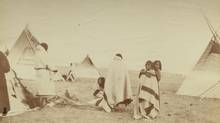Twenty years ago, Saskatoon scholar Laurie Barron cautioned that stories of sexual and physical abuse at Indian residential schools should be taken with a grain of salt; he thought they were just too horrific to be believed in their entirety. But national leader Phil Fontaine’s public admission of his abuse, the Royal Commission on Aboriginal People and the haunting testimony presented recently to the Truth and Reconciliation Commission of Canada have brought the horrors of the residential school system to the forefront of our consciousness. We are often shocked, but we really shouldn’t be surprised.
Nor should we be surprised by the revelations in Dr. Ian Mosby’s article about the medical experimentation on malnourished aboriginal people in northern Canada and in residential schools. Rather than feed the hungry among its wards (even adult “Registered Indians” were not full citizens until 1960), government-employed physicians used pangs of hunger to further their research into malnutrition, in a plot reminiscent of the Tuskegee experiment on African-Americans with syphilis, whose conditions were monitored rather than treated.
Researching my own book forced me to reconsider many of my long-held beliefs about Canadian history. A professor of mine at Trent University once explained that Canadian expansion into the West was much less violent than that of the United States’, because in that country, “the person with the fastest horse got the most land.” By contrast, in the Dominion’s march west, the land was prepared for settlement by government officials before the flood of immigrants.
What we didn’t know at the time was that a key aspect of preparing the land was the subjugation and forced removal of indigenous communities from their traditional territories, essentially clearing the plains of aboriginal people to make way for railway construction and settlement. Despite guarantees of food aid in times of famine in Treaty No. 6, Canadian officials used food, or rather denied food, as a means to ethnically cleanse a vast region from Regina to the Alberta border as the Canadian Pacific Railway took shape.
For years, government officials withheld food from aboriginal people until they moved to their appointed reserves, forcing them to trade freedom for rations. Once on reserves, food placed in ration houses was withheld for so long that much of it rotted while the people it was intended to feed fell into a decades-long cycle of malnutrition, suppressed immunity and sickness from tuberculosis and other diseases. Thousands died.
Sir John A. Macdonald, acting as both prime minister and minister of Indian affairs during the darkest days of the famine, even boasted that the indigenous population was kept on the “verge of actual starvation,” in an attempt to deflect criticism that he was squandering public funds.
Within a generation, aboriginal bison hunters went from being the “tallest in the world,” due to the quality of their nutrition, to a population so sick, they were believed to be racially more susceptible to disease. With this belief that aboriginal people were inherently unwell, their marginalization from mainstream Canada was, in a sense, complete.
For more than a century, Canadians have been accustomed to reports of terrible housing conditions on reserves, unsafe drinking water, dismal educational outcomes and, at least in Western Canada, prison populations disproportionally stacked with aboriginal inmates. Aboriginal leaders and young people such as those who embraced the Idle No More movement have been calling for Canadians to fundamentally acknowledge the injustices and atrocities of the past and fix the problems that keep indigenous Canadians from living the same quality of life as their non-aboriginal neighbours.
As the skeletons in our collective closet are exposed to the light, through the work of Dr. Mosby and others, perhaps we will come to understand the uncomfortable truths that modern Canada is founded upon – ethnic cleansing and genocide – and push our leaders and ourselves to make a nation we can be proud to call home.
Dr. James Daschuk is the author of Clearing the Plains: Disease, Politics of Starvation and the Loss of Aboriginal Life, an assistant professor in the faculty of kinesiology and health studies at the University of Regina and a researcher with the Saskatchewan Population Health and Evaluation Research Unit.
When Canada used hunger to clear the West
James Daschuk


























Laissez un commentaire Votre adresse courriel ne sera pas publiée.
Veuillez vous connecter afin de laisser un commentaire.
Aucun commentaire trouvé